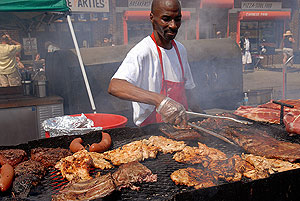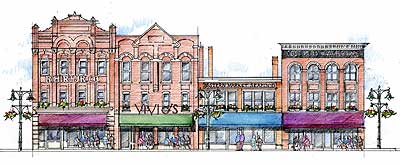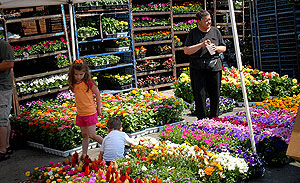Eastern Market’s New Chief
Chaotic vibrancy. Authenticity. Grit. Great food and specialty shops. The new Eastern Market chief is charged with taking all this and building something spectacular.
In November, Dan Carmody took the helm of the nonprofit charged with running Eastern Market and it couldn’t be a more exciting time for the neighborhood. Shed 2 is currently under renovation and two more will follow along with streetscape improvements for a total of $12.8 million investment.
A headhunter contacted Carmody about the position with Eastern Market Corp. while he was working for Fort Wayne Downtown Development District in Indiana. “The rest is kind of history,” he says. “I found the neighborhood compelling.”
 While his youngest daughter (he has six!) finishes high school, Carmody is commuting back and forth to Indiana some weekends, while renting a loft in the market for his local residence.
While his youngest daughter (he has six!) finishes high school, Carmody is commuting back and forth to Indiana some weekends, while renting a loft in the market for his local residence.
Model D sat down with him to get the scoop on his plans for Eastern Market.
Model D: How has your past experience prepared you for your work here in Detroit?
Dan Carmody: A schizophrenic childhood helped. I grew up in a big city – Chicago – but I spent a great deal of time on farms and smaller towns in Western Iowa.
As a bartender, I learned how to relate to a wide variety of people.
As a bar owner, I survived times when there wasn’t enough money in the account to cover my paycheck.
As a community-based developer in Rock Island and Fort Wayne, I led organizations charged with improving market dynamics of both their downtowns and older neighborhoods.
As a consultant, I had to think strategically about practical methods about how to improve more than thirty different communities across North America.
MD: What was better about Eastern Market than you could have hoped?
DC: Detroiters haven a great passion for Eastern Market, so there is much goodwill to tap into as the neighborhood improves.
MD: What have you already fallen in love with?
 DC: Saturdays at Eastern Market! There is a feeling of chaotic vibrancy. The market has great authenticity. It really is a unique place … a great platform from which to build.
DC: Saturdays at Eastern Market! There is a feeling of chaotic vibrancy. The market has great authenticity. It really is a unique place … a great platform from which to build.
MD: What needs the most help?
DC: The biggest challenge is building from the platform without screwing up the grittiness. My first inclination might have been to clean it up too much.
MD: What markets around the world or nation are you looking to for strategies?
DC: I’m still doing research on which are the best models, but we are looking at those that are similar in characteristics. Pike Street in Seattle is a great market that has been converted into a dynamic tourist attraction. The Eastern Market is mostly about food for Detroiters, and it might become more compelling as a tourist attraction, but only if we artfully hone its grittiness and retain its profound sense of authenticity.
MD: What are the steps the market needs to take to become a true 24-hour neighborhood? What will you do to make it more appealing to people who want to live there?
DC: We are already a true 24-hour neighborhood: wholesale food businesses operate in the time between midnight and 8 a.m. and we have a number of retail, service and offices that operate during the day. Our weakest time of day may be between 5 p.m. and midnight but we have a number of bars and restaurants, with more in the planning stages.
 With that said, there is great opportunity for the Market District to become a great mixed-use neighborhood with much more housing than is now the case. It is estimated that there are currently 75 lofts in the District with the capacity to develop 600 more units.
With that said, there is great opportunity for the Market District to become a great mixed-use neighborhood with much more housing than is now the case. It is estimated that there are currently 75 lofts in the District with the capacity to develop 600 more units.
To make the are more appealing in general, the public realm needs to be improved – streets, sidewalks, alleys, utilities and blight and graffiti need to be eliminated. The area needs to be more cared for which will be the biggest step towards making the District feel safer.
The Market District needs better connections to its surroundings, especially for non-auto circulation. The trail on the Dequindre Cut is a very important project for Eastern Market as is forging a better connection to the riverfront and downtown. We also hope to better connect the Market to Midtown.
MD: Similarly, how will you draw people there 7 days a week?
DC: Currently, wholesale merchants use EMC facilities six days a week from midnight to early morning. Many people don’t know about that activity.
No doubt the Market is busiest on Saturdays. As part of our plans to modernize the market is to convert Shed 3 into a year-round market hall and have it open several days a week.
 The recent study by Lasalle Bank (now Bank of America) identifying large parts of the city as food deserts clearly indicates a role the Market can play in better meeting the nutritional needs of Detroit residents.
The recent study by Lasalle Bank (now Bank of America) identifying large parts of the city as food deserts clearly indicates a role the Market can play in better meeting the nutritional needs of Detroit residents.
Lions tailgating is an example of a non-food related use that the Market attracts, but we have to be careful to keep our focus on food. We are looking to add an area for craft vendors on Market Saturdays – next to, but not under the sheds – and will continue to review all sorts of requests to use market facilities for events and festivals but are mindful that our farmers and vendors come first.
MD: How do you plan to encourage businesses to open in the market?
DC: The EMC was created to improve the operations of the market and make the Market District more hospitable to small business development. The Board of Directors is comprised of one-third District vendors and businesses, one-third city appointees – since the Market facilities remain city-owned – and finally, one-third those that have special interest in the Market – people such as foundations and the Michigan State University Extension Service. The Board provides the strong leadership needed to create a culture of nurturing small business development.
After building a strong organizational foundation, we are close to completing a strategic economic development strategy to create a coherent framework to guide new investment over the next decade.
A strong organization dedicated to the day to day improvement of the Market District and a sound and coherent strategy help provide investors with the confidence to take on projects in the Market District.
 We must also work to reduce the barriers to small business development process as transparent and predictable as possible.
We must also work to reduce the barriers to small business development process as transparent and predictable as possible.
MD: The shops in the market have some of the best specialty goods available anywhere in Metro Detroit. But they are hard to shop at during the week unless you have a flexible work schedule. Are there any plans to have a group of merchants stay open late one or two nights a week?
DC: As we add additional days of operation to the market hall, my preference would be to add one day at a time and stagger hours from current Saturday hours (7 a.m. to 4 p.m.) We will be doing more consumer research of nearby workers and residents to understand better what hours might work best on a middle of week market day.
With regards to individual shops, we will commence a series of training workshops for vendors and merchants alike. The first step in growing the Market District is improving the financial performance of existing businesses. For some it may be changing hours of operations, for others it may be internet sales.
Each business owner is the most knowledgeable person about their own business – all we can do and all an outside expert can do is bring fresh perspective. Operating a small business is a romantic notion to some but to operators, it is their life. Balance in the life of a small business owner’s life is hard to maintain. If the shop is open late, it takes time away from the family – those are the kinds of choice that have to be made.
MD: What are ways to diversity the produce/food mix in the market itself? Attract more organic and local food.?
 DC: Recruitment has already begun – we added Avalon Bakery and Hampshire Farms, a certified organic farm.
DC: Recruitment has already begun – we added Avalon Bakery and Hampshire Farms, a certified organic farm.
Early in 2008, we will establish an operations committee comprised of current vendors and EMC staff to establish minimum performance standards for vendors as part of out commitment to assure healthy food in the market. We will also be ramping up recruitment efforts at seeking more organic food and partnering more deeply with the folks at Greening of Detroit and the Garden Resource Program to increase food production within Detroit itself.
Food costs have gone up as we have tried to grow energy (ethanol) and we think the time is right to make food production more local and look forward to working with Mark Hamm, the head of MSU’s Sustainable Agriculture Program to address the long term security of food supplies for residents of Southeast Michigan.
MD: Will Eastern Market be challenged by the numerous small farmers markets opening up in Southeast Michigan?
DC: The good news is that there is an increasing interest in healthy and locally produced food — the bad news is that it will create more competition for what we do.
I’d still rather be in a growing market with one that is shrinking. Competition makes us stronger. Plus, we are authentic. Tents in a parking lot are not.
MD: Do you see a role for the market to play in bringing farmers and restaurants together with large-scale food providers such as business cafeterias and hospitals?
DC: The market already brings farmers and food service industry folks together six nights a week. We need to be more productive in improving and expanding the wholesale side of Eastern Market’s business mix as well as enhancing the retail side of the business.
MD: How will the appearance of the market, other than the sheds, be improved (streets, graffiti, etc.)?
DC: The eastern half of the Market District will become a denser, more walkable neighborhood in the years ahead as the western part of the Market District remains a place with larger scale operations.
Over the next ten years the charter school in the neighborhood will add junior and senior high grades, intensive agricultural will be integrated into open spaces and a greater diversity of retail and services will make the Eastern Market District among the greenest of Detroit’s neighborhoods. A great quality of life will create strong demand for the nearly 700 homes and strong business conditions will make the Eastern Market a great place to own a business.
Kelli B. Kavanaugh is development news editor of Model D.
Dan Carmody and Eastern Market Photos Copyright Dave Krieger




